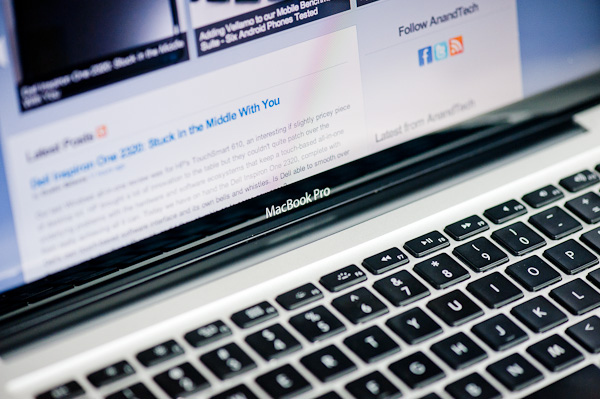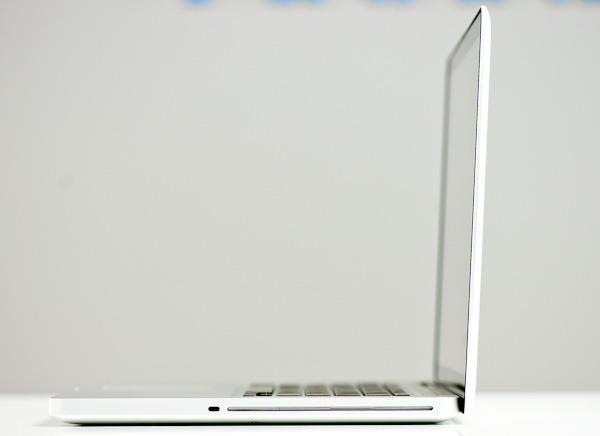Apple 15-inch MacBook Pro (Late 2011) Review
by Anand Lal Shimpi on November 17, 2011 5:10 PM EST- Posted in
- Mac
- Apple
- Intel
- MacBook Pro
- Sandy Bridge
- Laptops
Final Words
While I had a hard time recommending the base 15-inch MacBook Pro to users earlier this year, with the GPU upgrade I'm pretty happy with the $1799 configuration. It is pricey for sure, but if you can only have one Mac in your life and you like performance, it is probably the one to get.
The MacBook Air is nice but for demanding workloads it's not enough. The iMac is fast, but I'm not a fan of lugging around a 27-inch display with me wherever I go. The 15-inch MacBook Pro is honestly the best of both worlds. Obviously there are cheaper PC alternatives if you just need affordable compute, I'm speaking only to those users who have their sights set on something running OS X.
The only changes I'd make to the system are an upgrade in display resolution and the addition of an SSD. Both are options that Apple offers, and with the latter you can always handle that upgrade on your own.
At some point Apple will have to outfit these things with SSDs standard, similar to the MacBook Air. There's such a huge difference in user experience that it only makes sense to, the question is when?
For a while now we've heard rumors of a thinner, redesigned MacBook Pro without an optical drive. Removing the optical drive alone isn't enough to significantly decrease the thickness of the machine, Apple would have to move away from the 2.5" HDD form factor as well. Given that there are no reasonable performing HDDs in a smaller form factor, one would assume that if and when Apple removes the optical drive from the MacBook Pro, it will also remove the hard drive.
Ivy Bridge would be an interesting time to make such a drastic move, as Intel's 22nm process should be able to significantly reduce power consumption. Although the time may be right from a processor perspective, I wonder whether the MacBook Pro audience would be fine with only 128GB or 256GB of storage.
There is of course another option: expand the MacBook Air line with a larger (thicker?) 15-inch model. The trick here would be cramming a 35W quad-core chip into the system, otherwise it just becomes a 13-inch MBA with a bigger screen. That's where the thicker comment comes into play. Currently the MacBook Air only has to worry about dissipating 17W from the CPU, which includes the GPU. The 15-inch MacBook Pro however has a 45W quad-core CPU and a discrete GPU. Ivy Bridge will significantly increase integrated graphics performance, but not enough to truly eliminate the need for a discrete GPU. I suspect for Apple to do the ultra thin 15-inch MacBook Pro the right way it would have to wait until Haswell, where integrated graphics performance is supposed to be much better.
Of course all of this is speculating out loud, anything (or nothing) could happen. If you need a system today, the upgraded MacBook Pro line makes an an already great system a better value. If you can wait, Ivy Bridge will likely be very good for notebook users in about 6 - 8 months.
That's the downside to Intel's tick-tock cadence. When the ticks and tocks are major, there's almost never a good time to buy. Ivy Bridge will significantly reduce power consumption and improve GPU performance and then there's Haswell...
The next two years aren't going to be easy on anyone's wallet.












101 Comments
View All Comments
KoolAidMan1 - Friday, November 18, 2011 - link
"there are plenty of laptops that are designed to do real work for people that has real jobs"LOL
JarredWalton - Friday, November 18, 2011 - link
No one has Jobs any more. RIP. ;-)Corland - Tuesday, November 22, 2011 - link
Too soon Jarred.;-)
robco - Friday, November 18, 2011 - link
Your G73 is a 17" laptop and weighs over a kilo more (3.85 vs 2.54). Of course it's going to be faster. Many users are quite happy to have a thinner, lighter machine. If you care more about raw performance then the MBP is not for you. There's more to performance than fps numbers in games. Gaming has never been OS X's strong suit. For your needs, a Windows laptop is a much better choice.Personally, I wouldn't want to lug the ASUS around, but that's just me.
GotThumbs - Monday, November 21, 2011 - link
I think the key thing to keep in mind, is that you CAN obtain (minus TB Port) an equally impressive PC based laptop for significantly less cash. With the $aving$ of purchasing a PC over a MBP, you can then upgrade to 8Gigs of ram (for less than Apple charges) and load a decent SSD as well.The real question most general consumers ask themselves is.... Do you want to be seen with an Apple product or not, and how much am I willing to pay for that fashion accessory?
I'd be willing to bet that most MBP users (Include PC users as well) are not using even 50% of the systems capabilities. FB, Tweater, email, ITUNES do not utilize/need much processing power. In a society where woman can easily spend thousands on a purse, Apple has become somewhat of an accessory for women and men. I'm not saying ALL MPB users are motivated by fashion, but we all know a majority of users probably are. Just ask them about the specs and why thy chose an Apple laptop.
It's an individual choice of how one spends their hard earned money. Personally I choose to avoid Apples controlling environment and do not own a single Apple product.
Best Wishes,
Mystermask - Monday, November 28, 2011 - link
"Just ask them about the specs"Because specs tell so much about usability, productivity, TCO and value?
Personally I choose to avoid arrogant, narrow minded people.
CharonPDX - Thursday, November 17, 2011 - link
The Early 2011 model is the upgraded model, the Late 2011 model is the entry-level. So basically you're getting 99% of the prior "Upgraded" for the same price as the prior "Entry".gradjoh - Thursday, November 17, 2011 - link
Okay, thanks, that makes sense.zhill - Thursday, November 17, 2011 - link
The model he is reviewing is the "low end" 15" MBP, the other in the charts is the 2.3GHz upgraded "high end" MBP, so they aren't exactly apples-to-apples. Basically, the previous high end is still faster than the new low-end. It's a somewhat confusing comparison since he doesn't have numbers for the "low end" 2.0Ghz config of "early 2011". For the same $1799 you get a faster machine now, but the $2199 config from the last iteration is still faster.sigmatau - Friday, November 18, 2011 - link
Why would they use a $100 GPU in a $2500 laptop? Wow, now that is a ripoff.